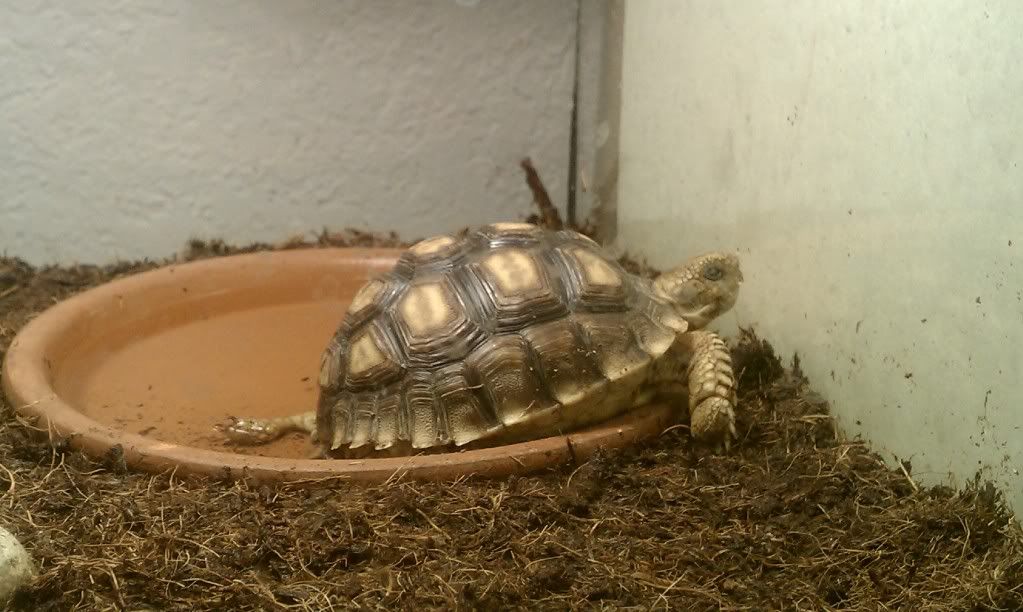I've been experimenting recently with the humidity in my reptile room and just wanted to share my observations out loud.
I have been trying to get adequate humidity levels for my Sulcata hatchling and haven't had much luck. A little background information. I live in Western Pennsylvania. The Humidity here isn't like Florida, but it's generally moderately high. The norm I'd say would be give or take 60%. It currently says on our local news website that it is 83% but that must be wrong. All my readings are at 60%, inside and out. Anyway, as I stated above I have been trying to get my reptile rooms humidity levels up to between 80% and 100% without much luck. I have installed multiple humidifiers into the room which literally make a cloud and my gauges still aren't reading over 84%. The room isn't too large and has absolutely no windows and one door. It's very well insulated and completely isolated.
In light of these tests I have concluded that it's probably not appropriate for me to keep the Sulcata in a Tortoise Table, atleast not now. I have decided to move him into a 100 gallon Acrylic aquarium. It's one of those kind that the tops are partially covered and there's two separate rectangles on the top to have access to what's inside; like the kind used for tropical fish. To increase the humidity I'm going to completely cover up the one opening with cling wrap and let his basking light hang down through the other. If I keep it moist in there it should hold the humidity like a champ. Also, I used Coir and Sphagnum Moss as my bedding inside my tortoise table. I think I'm going to use just Coir this time. Reason being is that it seems to hold moisture much better and I think I have caught him eating the Moss from time to time.
I'm terrified of him pyramiding, that's why I've decided to do all of this. I've read a lot of the threads about it and it seems that the humidity levels may be the culprit. Anyway, I just needed to share my thoughts. If you'd like I always appreciate feedback.
Thanks
Matt
I have been trying to get adequate humidity levels for my Sulcata hatchling and haven't had much luck. A little background information. I live in Western Pennsylvania. The Humidity here isn't like Florida, but it's generally moderately high. The norm I'd say would be give or take 60%. It currently says on our local news website that it is 83% but that must be wrong. All my readings are at 60%, inside and out. Anyway, as I stated above I have been trying to get my reptile rooms humidity levels up to between 80% and 100% without much luck. I have installed multiple humidifiers into the room which literally make a cloud and my gauges still aren't reading over 84%. The room isn't too large and has absolutely no windows and one door. It's very well insulated and completely isolated.
In light of these tests I have concluded that it's probably not appropriate for me to keep the Sulcata in a Tortoise Table, atleast not now. I have decided to move him into a 100 gallon Acrylic aquarium. It's one of those kind that the tops are partially covered and there's two separate rectangles on the top to have access to what's inside; like the kind used for tropical fish. To increase the humidity I'm going to completely cover up the one opening with cling wrap and let his basking light hang down through the other. If I keep it moist in there it should hold the humidity like a champ. Also, I used Coir and Sphagnum Moss as my bedding inside my tortoise table. I think I'm going to use just Coir this time. Reason being is that it seems to hold moisture much better and I think I have caught him eating the Moss from time to time.
I'm terrified of him pyramiding, that's why I've decided to do all of this. I've read a lot of the threads about it and it seems that the humidity levels may be the culprit. Anyway, I just needed to share my thoughts. If you'd like I always appreciate feedback.
Thanks
Matt
